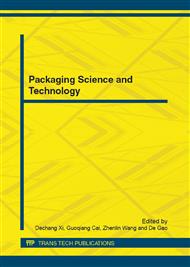p.321
p.325
p.331
p.335
p.339
p.343
p.347
p.351
p.356
Preparation of Silica Hollow Spheres Used as Filler for Paper
Abstract:
Silica of hollow structure exhibits a number of special characteristic. In this paper, a new way to prepare hollow silica spheres which can be used as filler for paper was reported. In this approach, when silica shells were coated on polyvinylacetate (PVAc) template particles by the sol-gel method, the PVAc cores would be dissolved synchronously, forming hollow spheres. Neither additional dissolution nor a calcination process was needed to remove the PVAc cores. The morphology of the hollow silica spheres was also characterized by TEM. It was shown that the hollow silica spheres with 130-400nm in diameter and 15-35nm in the shell thickness could be synthesized. The possible formation mechanism was also brought forward. The possibility and potential advantages in usage as filler for paper were analyzed theoretically. We confer that this filler can improve the printability of the paper, and reduce its density compared with traditional fillers.
Info:
Periodical:
Pages:
339-342
Citation:
Online since:
October 2012
Authors:
Keywords:
Price:
Сopyright:
© 2012 Trans Tech Publications Ltd. All Rights Reserved
Share:
Citation:


